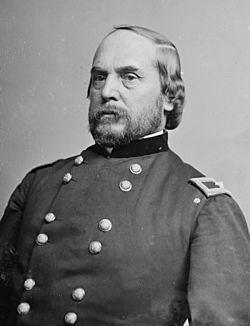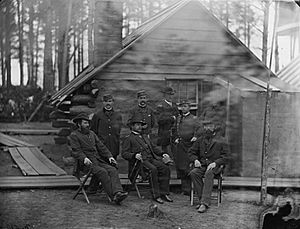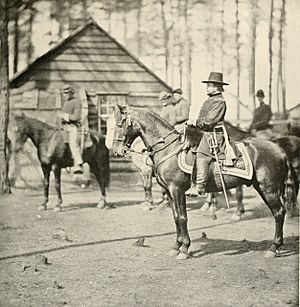Rufus Ingalls facts for kids
Quick facts for kids
Rufus Ingalls
|
|
|---|---|
 |
|
| Born | August 23, 1818 Denmark, Maine |
| Died | January 15, 1893 (aged 74) New York City, New York |
| Place of burial | |
| Allegiance | United States of America Union |
| Service/ |
United States Army Union Army |
| Years of service | 1843–1883 |
| Rank | |
| Commands held | Quartermaster General of the United States Army |
| Battles/wars | Mexican–American War American Civil War |
Rufus Ingalls (born August 23, 1818 – died January 15, 1893) was an American military general. He held an important job as the 16th Quartermaster General for the United States Army. This means he was in charge of getting all the supplies, like food, clothes, and equipment, to the soldiers.
Contents
Early Life and Military Start
Rufus Ingalls was born in a small town called Denmark in Maine. Back then, Maine was part of Massachusetts. His father, Cyrus, owned a mill and was involved in local politics. Thanks to his father's connections, Rufus got to go to the United States Military Academy (West Point). He graduated in 1843. One of his good friends there was Ulysses S. Grant, who later became a famous general and president.
After West Point, Ingalls became a Second Lieutenant. He was sent to work at military bases in the western parts of the country.
Serving in the Mexican-American War
In 1845, Ingalls joined the First U.S. Dragoons as a first lieutenant. He fought in the Mexican–American War in the New Mexico Territory. He was part of the Army of the West, led by Col. Stephen W. Kearny. Ingalls showed great bravery in battles at Eabudo and Pueblo de Taos. Because of his actions, he was given the special rank of brevet first lieutenant. After the war, he worked in California with Kearny. In 1848, he became a quartermaster, and he stayed in this role for the rest of his career. A quartermaster is someone who manages supplies for the army.
Life in the Oregon Territory
In 1849, Ingalls was promoted to captain and sent to the Oregon Territory. By 1852, he was at Fort Vancouver, where his friend Ulysses Grant was also stationed. While there, he joined the local Freemasons, a social group. In 1854, Ingalls was ordered to travel across the country from Fort Leavenworth in Kansas to the Pacific Coast.
Civil War Service

When the Civil War began in April 1861, Ingalls was sent to Fort Pickens in Florida. He quickly rose through the ranks, becoming a major and then a lieutenant colonel. After the First Battle of Manassas in July, he moved to Virginia. There, he became an aide-de-camp (a personal assistant) to Maj. Gen. George B. McClellan. In January 1862, he was promoted to major.
Supplying the Army
Ingalls was very good at his job. He helped set up important supply centers for McClellan's Army of the Potomac during the Peninsula Campaign. These centers were in places like Yorktown and White House Landing. He was so skilled that he managed to move all the supplies, vehicles, and workers safely from White House Landing during the difficult Seven Day's Battles.
Because of his excellent work, he became the Chief Quartermaster of the Army of the Potomac in August 1862. He continued to do his job very well during the Northern Virginia and Maryland Campaigns. People praised his amazing skills in logistics, which is the detailed planning and organization of complex operations, like moving supplies for an army.
Working with General Grant
In June 1864, his old friend Ulysses S. Grant put Ingalls in charge of all supplies for the Federal armies fighting near Petersburg and Richmond. His main supply base at City Point, Virginia, became the biggest port operation in the entire Western Hemisphere at that time.
Ingalls earned special brevet ranks of major general in both the regular army and the volunteer army for his outstanding service.
After the War
After Robert E. Lee surrendered in April 1865, ending the Civil War, Ingalls left the City Point supply base in May. He went back to Washington, D.C. In July 1866, he was given the rank of colonel in the Regular Army. For the next twenty years, he worked in different quartermaster jobs in cities like New York City, San Francisco, and Chicago. For sixteen years, he was the chief quartermaster for the Pacific and Missouri regions.
On February 23, 1882, Rufus Ingalls was named the 16th Quartermaster General of the U.S. Army, with the full rank of brigadier general. He retired from the army in 1883 and moved to Oregon. In 1891, he moved to New York City, where he passed away two years later at 74 years old. He was buried with military honors at Arlington National Cemetery.
Honors and Legacy
A street in San Francisco is named Ingalls Street in his honor. In 1987, Rufus Ingalls was added to the Quartermaster Hall of Fame, which recognizes people who have made important contributions to the army's supply and logistics efforts.


